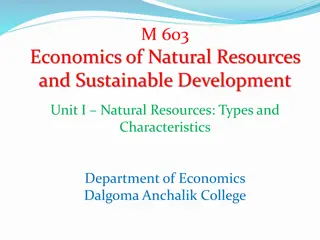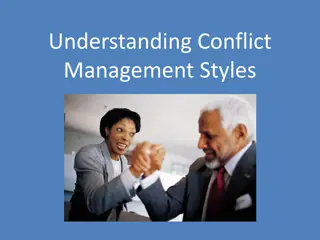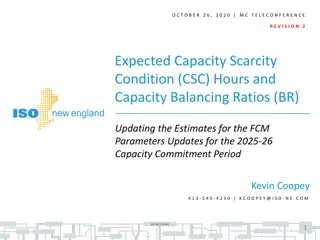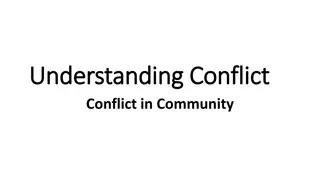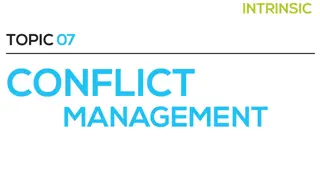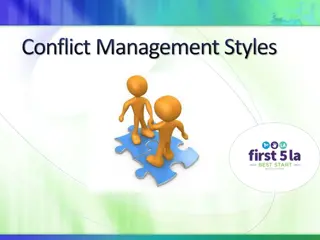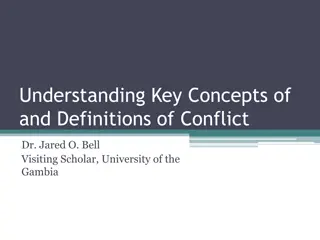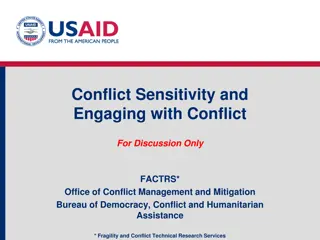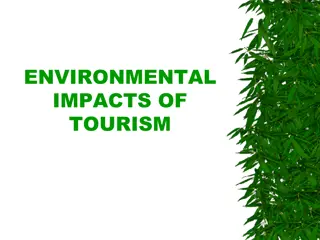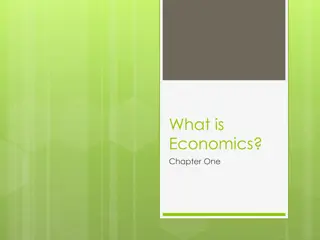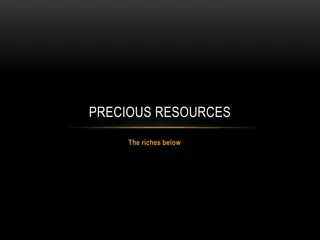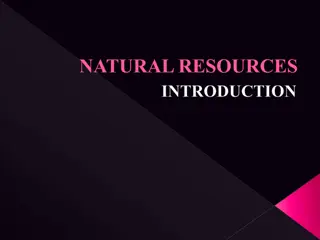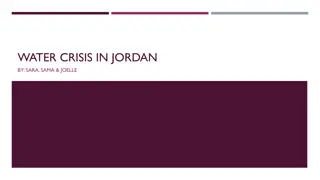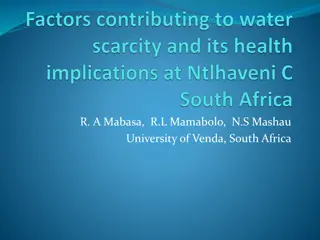Natural Resources and Conflict: Stakeholders, Scarcity, and Impacts
The interplay between natural resources and conflict is examined, discussing stakeholders involved, potential scarcity conflicts, and the impact of resource abundance on conflict intensity. Examples such as Darfur highlight the complexities of resource-related conflicts. The significance of resource wealth, various mechanisms influencing conflicts, and the role of different commodities are explored to understand the dynamics of conflicts linked to natural resources.
Download Presentation

Please find below an Image/Link to download the presentation.
The content on the website is provided AS IS for your information and personal use only. It may not be sold, licensed, or shared on other websites without obtaining consent from the author.If you encounter any issues during the download, it is possible that the publisher has removed the file from their server.
You are allowed to download the files provided on this website for personal or commercial use, subject to the condition that they are used lawfully. All files are the property of their respective owners.
The content on the website is provided AS IS for your information and personal use only. It may not be sold, licensed, or shared on other websites without obtaining consent from the author.
E N D
Presentation Transcript
1 Natural Resources and Conflict
Natural Resources What are natural resources? The World Bankdefines natural resources as All gifts of nature air, land, water, forests, wildlife, topsoil, minerals used by people for production or for direct consumption. Can be either renewable or nonrenewable. Natural resources include natural capital plus those gifts of nature that cannot be stocked (such as sunlight) or cannot be used in production (such as picturesque landscapes). e.g., water, land, timber, oil and gas, minerals. How? & Examples? Water (drinkable water & bodies of water) 2 Lecture Source: A Study Guide Series on Peace and Conflict. United State Institute of Peace.
Natural Resources 3 Stakeholders These stakeholders may include local communities, governments, rebel groups, and outside actors. Relationship Local communities: income, industry, culture Government: resource management Rebel groups: to purchase arms and mobilize fighters Outside actors: to establish standards (e.g. UN, the World Bank, IMF) Lecture Source: A Study Guide Series on Peace and Conflict. United State Institute of Peace.
Natural Resources: Little V.S. Much 4 Little Resource Scarcity Conflict As the global population continues to rise, and the demand for resources continues to grow, there is significant potential for conflicts over resources to intensify (UNEP, 2009). Examples/Evidence: Darfur (Sudan) Much Resource Abundance Conflict Examples/Evidence Conclusion: Little V.S. Much? Lecture Source: A Study Guide Series on Peace and Conflict. United State Institute of Peace.
Natural Resources: Little V.S. Much 5 Source: Sachs & Warner (2001)
Natural Resources: Little V.S. Much 6 Source: Ross (2004)
Ross: Conclusions 7 Good evidence for a link to natural resources in these conflicts (although reverse causation is possible) Oil, non-fuel minerals, drugs are important; other primary commodities are not Neither looting not grievance important for the onset of conflicts Resource wealth does not always make conflicts worse, although net effect negative Not one mechanism but many Some unanticipated mechanisms (booty futures, preemptive repression)
8 A Causal Exploration of Food Price Shocks and Conflict in Sudan Directed by Dr. David A. Bessler Dr. Shahriar Kibriya Dr. Edwin C. Price
Introduction 9 Background of Sudan Once the largest states in Africa; split into two countries on July 9th, 2011, after the people of the South voted for independence; Conflicts: Two rounds North-South interval war (1955-1972; 1983-2005) Conflicts exist despite independence: border issues; sharing of debt and oil revenues, etc. Agriculture: Sorghum, millet and wheat ---- major staple cereals food Sorghum and millet are largely localized, but almost all of the wheat consumed in Sudan are imported. The map is from BBC Sudan Profile .
Introduction 10 Motivation Sudan has been suffering from violent conflicts for most of its history; Two main food crisis (hike) since 2000 (2007 2008; 2010 2011) Sudan: staple food prices hike as well High cereal prices Food insecurity Conflicts ??? Historical Evidence partial cause Arab Spring (2010 present): From the start, food has played a bigger role in the upheavals than most people realize. (The Economist January 2012) French Revolution (1789-1799): Carlyle attributes food prices as a
Objectives and Approach Objective: 11 explore the causality relationship and offer policy implication: cereals prices conflicts in Sudan??? Note that ??????????? ?????????. Approach: Estimating the time series dataset based on Subset Vector Autoregression Model (SVAR); Obtaining the contemporary causal structure by Directed Acyclic Graph (DAG): A picture of directed edges with no cycles which presents causal ordering among a set of variables (eg: ?_1 ?_2 ) Using the Impulse Response Function (IRF) and Forecast Error Variance Decompositions (FEVD) to conduct dynamic analysis.
Data Description 12 Data Source Commodity prices: Food and Agricultural Organization (FAO) of the United Nations (wheat, sorghum, millet) Conflicts: Armed Conflict Location & Event Dataset (ACLED) (number of conflicts) Time period: 2001.1 2012.12 (monthly data) Series Units Number of Conflicts/Month Wheat Price Pound/90kg Sorghum Price Pound/90kg Millet Price Pound/90kg Standard Deviation 21.084 Coefficient of Variation 0.922 Mean Conflict in Sudan 22.868 Sudanese 98.466 38.109 0.387 Sudanese 74.377 40.418 0.543 Sudanese 108.250 62.375 0.576
Data Description 13 Time plots of four variables
Results 1 DAG 14 Directed Acyclic Graph (DAG): Causal Flow Among Innovations in Conflict, Wheat Price, Sorghum Price and Millet Price
Results 2 FEVD 15 Forecast Error Variance Decompositions (FEVD) Horizon (Months Ahead) Price Due to: Wheat Due to : Conflict in Sudan Due to: Due to: Millet Price Sorghum Price (Conflicts in Sudan) 0 0.006 0.046 0.000 99.948 1 0.561 0.045 0.000 99.394 2 1.608 0.045 0.000 98.347 12 12.745 0.040 0.000 87.215 24 17.356 0.038 0.000 82.606
Results 3 IRF 16 Impulse Response Function (IRF)
Conclusion 17 Primary Results Only the price of wheat has an effect on the number of conflicts in Sudan; neither the price of sorghum nor the millet will affect the conflicts situation in Sudan. Fact: Sorghum has been the most popular staple food of Sudan; in recent years consumer preferences, especially in urban areas have shifted to wheat; a majority of wheat consumption is imported from the international market. Uniqueness and Possible Extension Uniqueness: to our knowledge, the first one to explore the causality between commodity prices and conflicts in Sudan. Extension: try to include the role of South Sudan in the dataset.
Thank you Questions?



